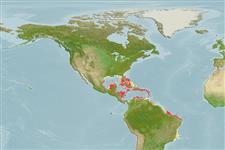>
Eupercaria/misc (Various families in series Eupercaria) >
Labridae (Wrasses) > Xyrichtyinae
Etymology: Xyrichtys: Greek, xyreo = that cuts like a knife + Greek, ichthys = fish (Ref. 45335).
More on author: Valenciennes.
Environment: milieu / climate zone / depth range / distribution range
Οικολογία
Θαλασσινό(ά) Υφαλόφιλο(α); εύρος βάθους 2 - 21 m (Ref. 7251). Subtropical
Western Atlantic: southern Florida, USA and Bahamas to northern South America.
Μέγεθος / Βάρος / Age
Maturity: Lm ? range ? - ? cm
Max length : 15.0 cm TL αρσενικό/απροσδιόριστο; (Ref. 7251)
Short description
Μορφολογία | Μορφομετρία
Females light greenish gray, becoming pinkish ventrally, with diffuse orange-red stripe from behind eye to base of caudal fin; a broad white area over abdomen, the lower part with vertical lines of red; there may be faint red bars on the body. Large adult males lose the distinctive red, white and black markings; they develop a vertically elongate blue spot on each body scale; a yellow head with near-vertical pale blue bands, and a large dark spot in axil of pectoral fins (Ref. 13442).
Most common in open sandy areas. Feeds on small sand-dwelling invertebrates. Dives head first into the sand when frightened. Generally common (Ref. 9710). Generally of no interest to fisheries because of its small average size (Ref. 5217).
Life cycle and mating behavior
Γεννητική Ωρίμανση | Αναπαραγωγή | Γεννοβολία | Αβγά | Γονιμότητα | Προνύμφες
Robins, C.R. and G.C. Ray, 1986. A field guide to Atlantic coast fishes of North America. Houghton Mifflin Company, Boston, U.S.A. 354 p. (Ref. 7251)
IUCN Red List Status (Ref. 130435)
Threat to humans
Harmless
Human uses
Ενυδρείο: Εμπορικό(ά)
Περισσότερες πληροφορίες
Κοινά ονόματαΣυνώνυμαΜεταβολισμόςΘηρευτέςΟικοτοξικολογίαΑναπαραγωγήΓεννητική ΩρίμανσηΓεννοβολίαΣυναθροίσεις γεννοβολίαςΓονιμότηταΑβγάEgg development
ΑναφορέςΥδατοκαλλιέργειεςΠροφίλ υδατοκαλλιέργειαςΣτελέχοιΓενετικήElectrophoresesΚληρονομικότηταΑσθένειεςΜεταποίησηNutrientsMass conversion
ΣυνεργάτεςΦωτογραφίεςStamps, Coins Misc.ΉχοιΣιγκουατέραΤαχύτηταΚολυμβητικός ΤύποςΕπιφάνεια βραγχίωνOtolithsΕγκέφαλοιΌραση
Εργαλεία
Special reports
Download XML
Διαδικτυακές πηγές
Estimates based on models
Preferred temperature (Ref.
123201): 25.1 - 28.2, mean 27.4 °C (based on 619 cells).
Phylogenetic diversity index (Ref.
82804): PD
50 = 0.5005 [Uniqueness, from 0.5 = low to 2.0 = high].
Bayesian length-weight: a=0.00676 (0.00275 - 0.01660), b=3.05 (2.84 - 3.26), in cm total length, based on LWR estimates for this (Sub)family-body shape (Ref.
93245).
Τροφικό Επίπεδο (Ref.
69278): 3.5 ±0.37 se; based on food items.
Ελαστικότητα (Ref.
120179): Υψηλό, ελάχιστος χρόνος για διπλασιασμό πληθυσμού < 15 μήνες (Preliminary K or Fecundity.).
Fishing Vulnerability (Ref.
59153): Low vulnerability (10 of 100).
Nutrients (Ref.
124155): Calcium = 65.3 [27.2, 142.0] mg/100g; Iron = 0.678 [0.355, 1.489] mg/100g; Protein = 18.7 [15.8, 21.0] %; Omega3 = 0.147 [0.074, 0.285] g/100g; Selenium = 11.4 [4.8, 27.1] μg/100g; VitaminA = 85.4 [22.3, 426.5] μg/100g; Zinc = 1.19 [0.69, 2.13] mg/100g (wet weight);
